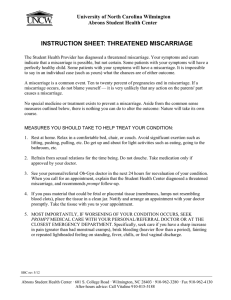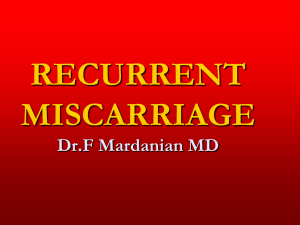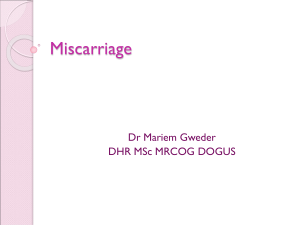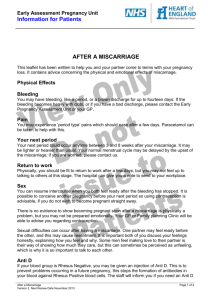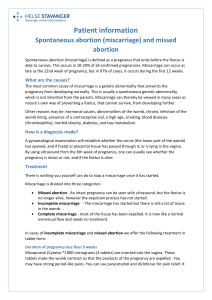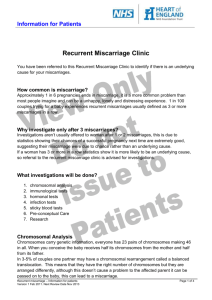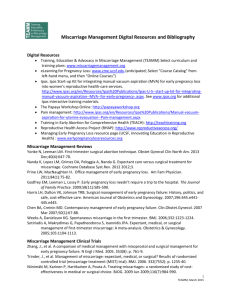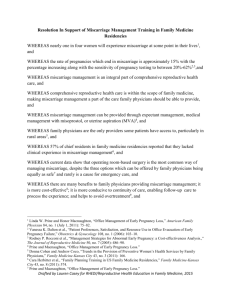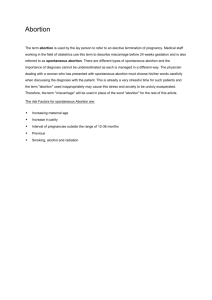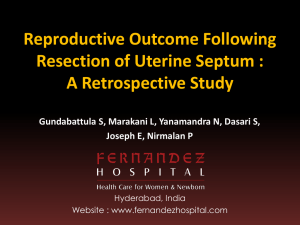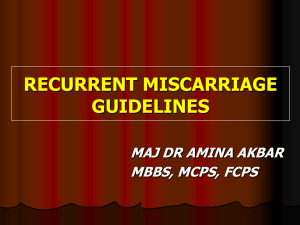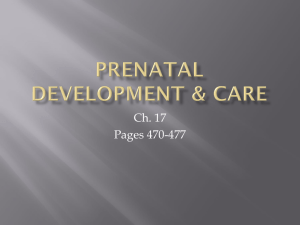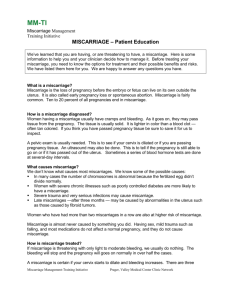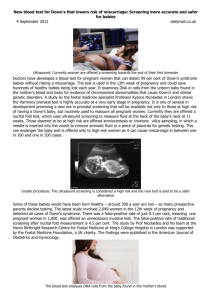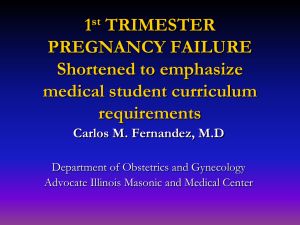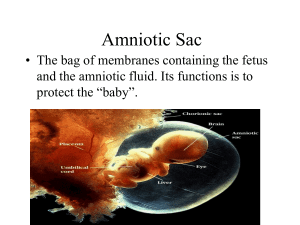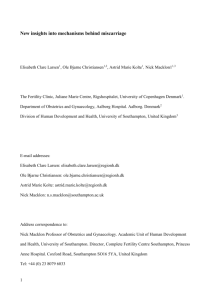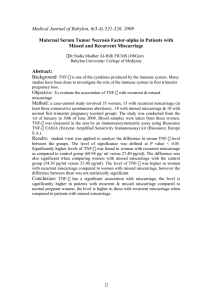Environmental causes of Miscarriage
advertisement
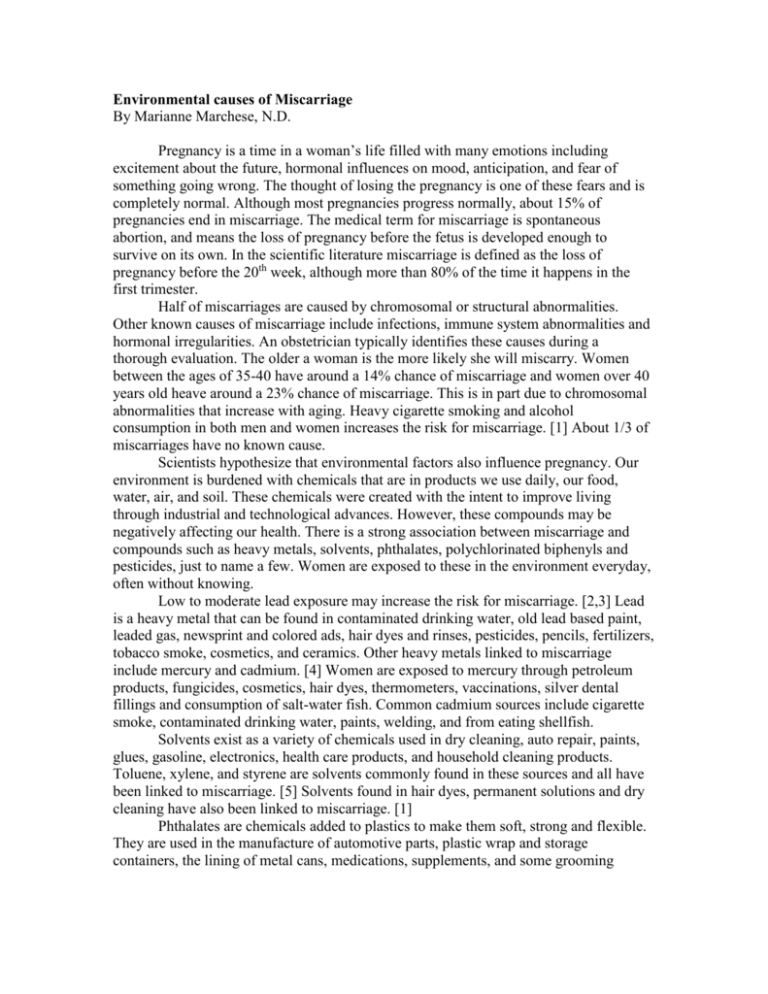
Environmental causes of Miscarriage By Marianne Marchese, N.D. Pregnancy is a time in a woman’s life filled with many emotions including excitement about the future, hormonal influences on mood, anticipation, and fear of something going wrong. The thought of losing the pregnancy is one of these fears and is completely normal. Although most pregnancies progress normally, about 15% of pregnancies end in miscarriage. The medical term for miscarriage is spontaneous abortion, and means the loss of pregnancy before the fetus is developed enough to survive on its own. In the scientific literature miscarriage is defined as the loss of pregnancy before the 20th week, although more than 80% of the time it happens in the first trimester. Half of miscarriages are caused by chromosomal or structural abnormalities. Other known causes of miscarriage include infections, immune system abnormalities and hormonal irregularities. An obstetrician typically identifies these causes during a thorough evaluation. The older a woman is the more likely she will miscarry. Women between the ages of 35-40 have around a 14% chance of miscarriage and women over 40 years old heave around a 23% chance of miscarriage. This is in part due to chromosomal abnormalities that increase with aging. Heavy cigarette smoking and alcohol consumption in both men and women increases the risk for miscarriage. [1] About 1/3 of miscarriages have no known cause. Scientists hypothesize that environmental factors also influence pregnancy. Our environment is burdened with chemicals that are in products we use daily, our food, water, air, and soil. These chemicals were created with the intent to improve living through industrial and technological advances. However, these compounds may be negatively affecting our health. There is a strong association between miscarriage and compounds such as heavy metals, solvents, phthalates, polychlorinated biphenyls and pesticides, just to name a few. Women are exposed to these in the environment everyday, often without knowing. Low to moderate lead exposure may increase the risk for miscarriage. [2,3] Lead is a heavy metal that can be found in contaminated drinking water, old lead based paint, leaded gas, newsprint and colored ads, hair dyes and rinses, pesticides, pencils, fertilizers, tobacco smoke, cosmetics, and ceramics. Other heavy metals linked to miscarriage include mercury and cadmium. [4] Women are exposed to mercury through petroleum products, fungicides, cosmetics, hair dyes, thermometers, vaccinations, silver dental fillings and consumption of salt-water fish. Common cadmium sources include cigarette smoke, contaminated drinking water, paints, welding, and from eating shellfish. Solvents exist as a variety of chemicals used in dry cleaning, auto repair, paints, glues, gasoline, electronics, health care products, and household cleaning products. Toluene, xylene, and styrene are solvents commonly found in these sources and all have been linked to miscarriage. [5] Solvents found in hair dyes, permanent solutions and dry cleaning have also been linked to miscarriage. [1] Phthalates are chemicals added to plastics to make them soft, strong and flexible. They are used in the manufacture of automotive parts, plastic wrap and storage containers, the lining of metal cans, medications, supplements, and some grooming products. Several studies link phthalates to hormone disrupting conditions in women, and they are linked to miscarriages in rats. [5] Polychlorinated biphenyl (PCB’s) and pesticide exposure increases the risk for miscarriage. [1,5,6,7] PCB’s were once used in electrical transformers, capacitators, plasticizers and adhesives. Although many are no longer used in the U.S. they still persist in the environment. Eating fish from contaminated waters, and farm-raised fish, are a major source of PCB’s as well as dairy and meat products. Pesticides are widely used in agriculture and home lawn care. Some have been banned due to their toxic side effects but these too persist in the environment today. Our major source of exposure is pesticide residue on non-organic fruits and vegetables. Everyday women are exposed to these compounds. It is clear that environmental factors need to be evaluated when the cause of miscarriage is unknown. Some may argue that environmental toxins can account for some of the known causes of miscarriage such as chromosomal, immune and hormonal abnormalities. Regardless, a thorough environmental evaluation should be considered. A physician experienced in environmental medicine can test for these compounds in the blood and body tissues. Blood test can tell if there was recent exposure to these toxins. Tissue samples can determine how much is retained in the body from years of cumulative exposure. Most of these compounds are fat soluble, meaning they are stored in the body’s fat, and have the ability to hang around for years. Since we are exposed to low levels of many toxic compounds on a daily basis it is plausible they can accumulate in the tissues, and eventually lead to adverse health effects such as miscarriage. If testing reveals that toxic compounds are present in the body a comprehensive cleansing protocol can be designed by an experienced physician. Pharmaceutical agents are available to bind heavy metals and remove them from the body. Specific vitamins, minerals, herbs and amino acids are known to assist the body in detoxifying pesticides, solvents and other chemicals. It is important to follow a comprehensive program individually designed for you that includes supporting the bodies’ ability to eliminate toxins. This means the kidneys, liver, and bowel must be working optimally. Since the skin is another means of eliminating toxins and a good cleansing protocol would include promoting excretion through sweating. Prevention is the key to optimal health. It is never too late to take steps to reduce one’s exposure to environmental toxins. The simplest and most cost effective ways are as follows; 1. Buy only organic fruits and vegetables 2. Buy only wild fish, not farmed, that are known to be low in mercury 3. Eat only organic meat and dairy products 4. Drink only filtered water 5. Use an air purifier in the home and office 6. Minimize the use of plastic including storage containers, wraps, condiments, and bottles 7. Do not use pesticides or insecticides around the home 8. Use toxin free cosmetics, cleaners and grooming products 9. Limit hobbies involving solvents and heavy metals or wear gloves and a filtered mask to reduce exposure 10. Visit a biological dentist in your area if you need fillings 11. Stop smoking and avoid places that allow smoking There are many resources available that provide alternatives to cleaning and grooming products, home building supplies, and pesticide use. Also many organizations provide updated lists of foods lowest in mercury, PCB’s, and pesticides. Check out; nottoopretty.org thegreenguide.com pesticide.org foodnews.org Environmental exposures should not be overlooked when trying to achieve a successful pregnancy. It is not necessary to live in fear but it is important to educate ourselves and others of the potential health risks associated with compounds in our environment. If you feel you have a history of exposure to toxins that may be contributing to your health, seek medical advice. Again, finding a physician experienced in this type of medicine is vital to the testing and cleansing process. References: 1. Hruska KS, et al. Environmental factors in infertility. Clin Obst Gyn. 2000;43(4):821-829. 2. Hertz-Picciotto I. The evidence that lead increases the risk for spontaneous abortion. Am J Ind Med. 2000;38:300-309. 3. Borja-Aburto V.H, et al. Blood lead levels measured prospectively and risk of spontaneous abortion. Am J Epid. 1999;150(6):590-597. 4. Gerhard I, et al. Impact of heavy metal on hormonal and immunological factors in women with repeated miscarriages. Hum Rep Update. 1998;4(3):301-309. 5. Sharara Fi, et al. Environmental toxicants and female reproduction. Fertility and Sterility. 1998;70(4):613-622. 6. Gerhard I, et al. Chlorinated hydrocarbons in women with repeated miscarriages. Env Health Persp. 1998;106(10):675-681 7. Nicolopoulou-Stamati P, Pitsos MA. The impact of endocrine disruptors on the female reproductive system. Hum Rep Update. 2001;7(3):323-330.
